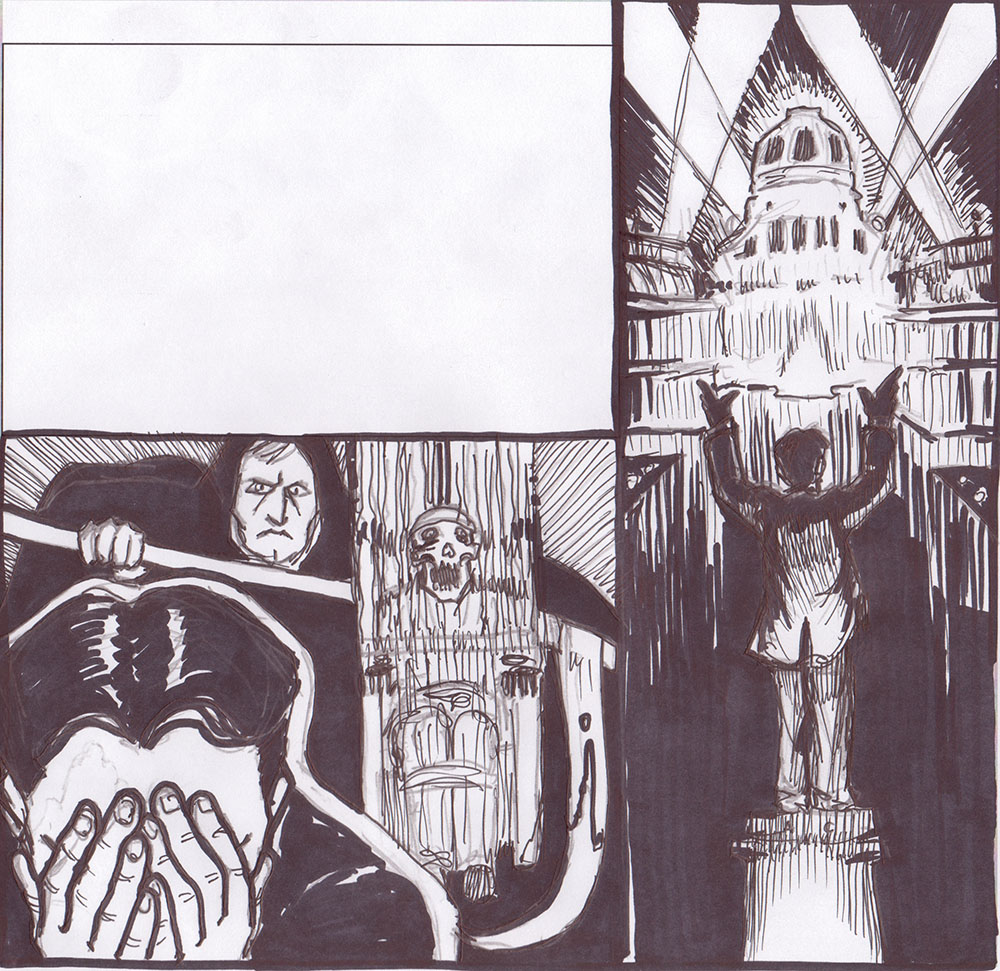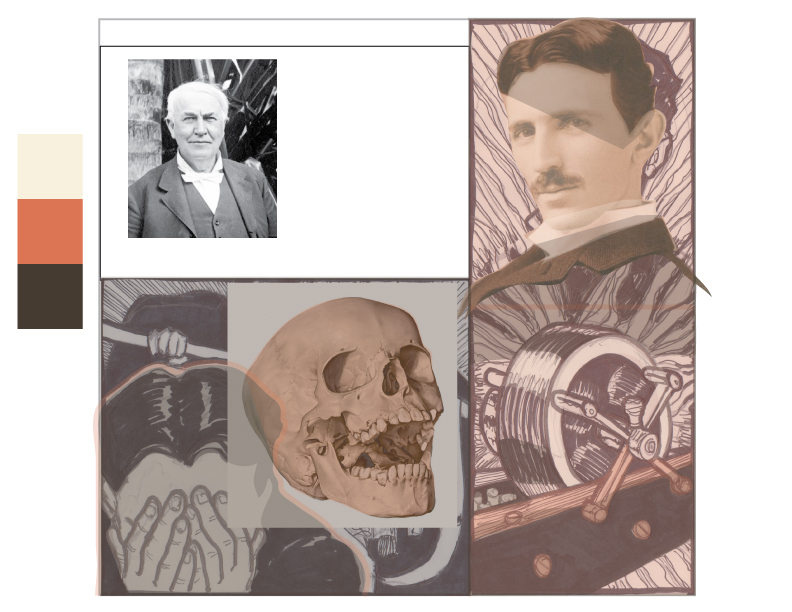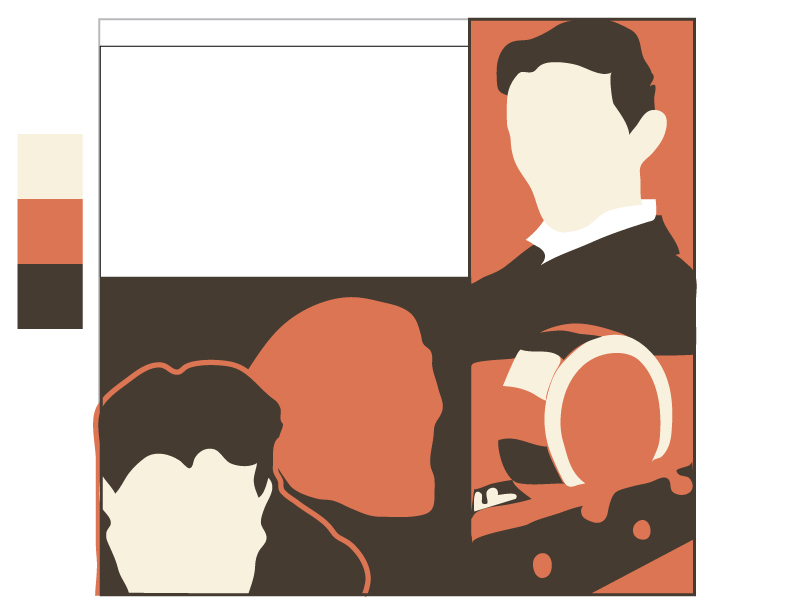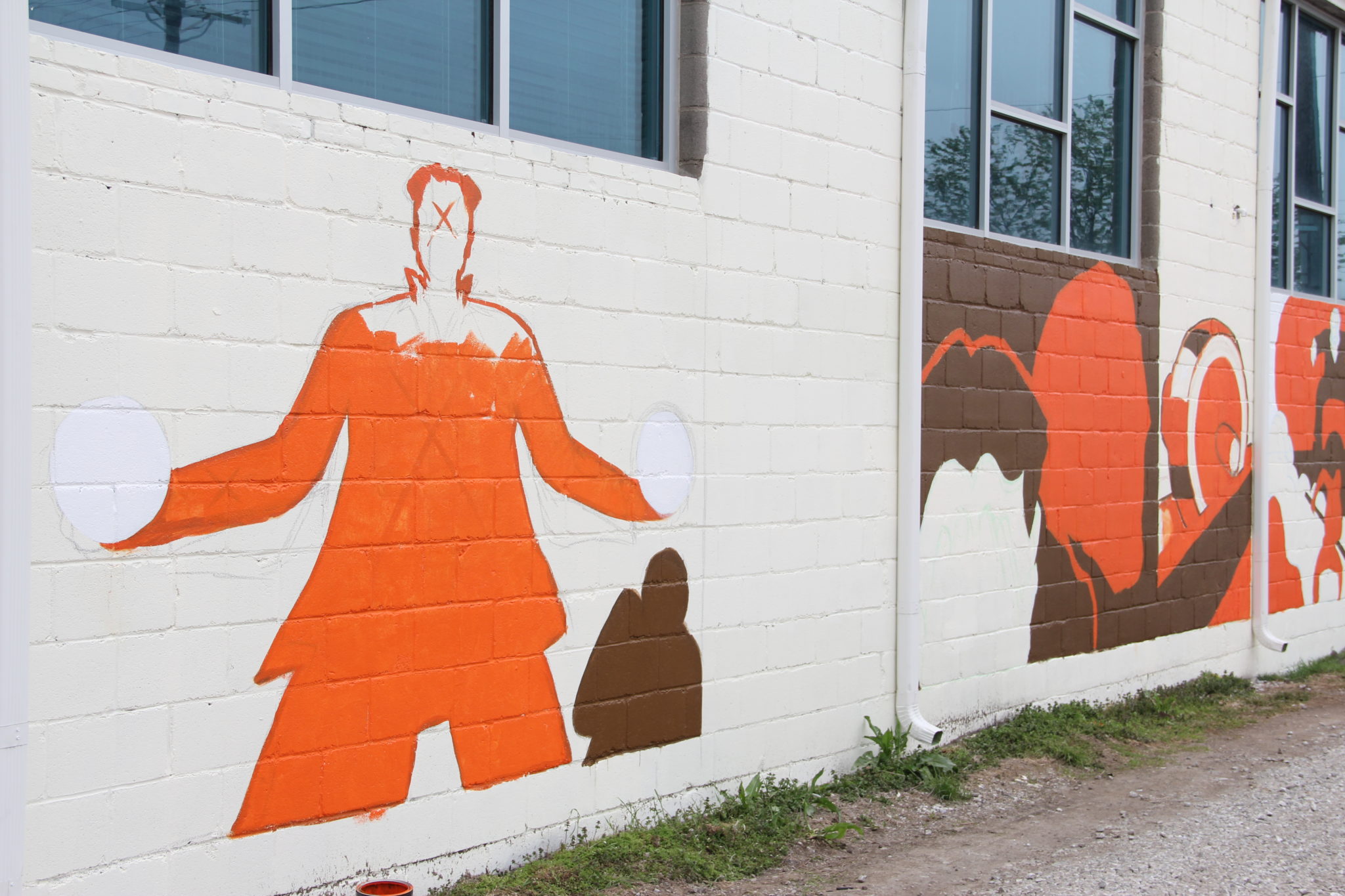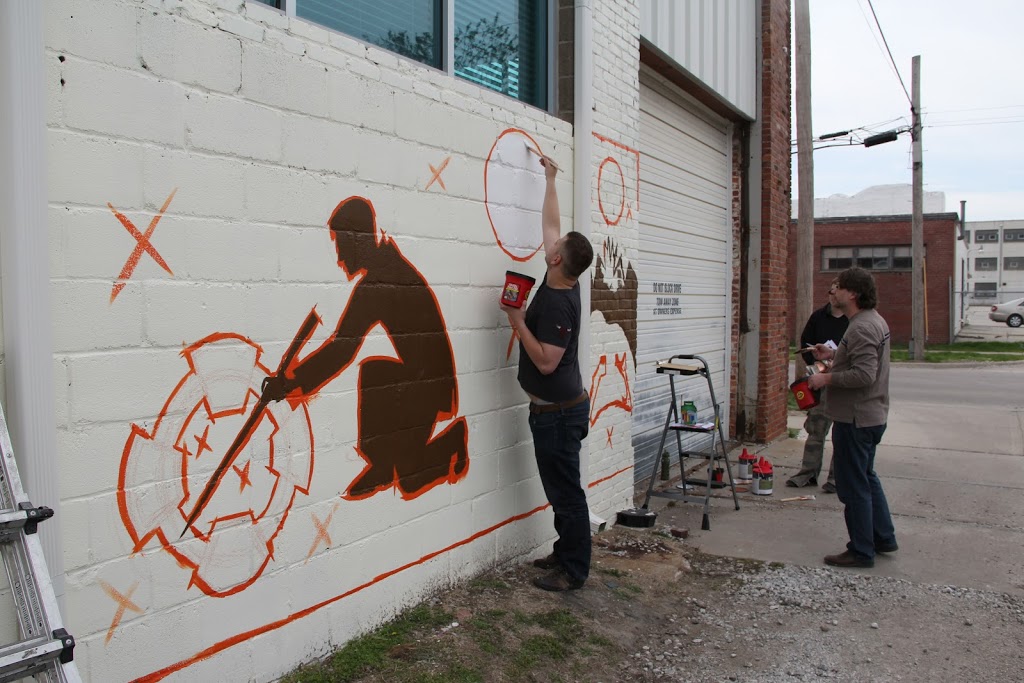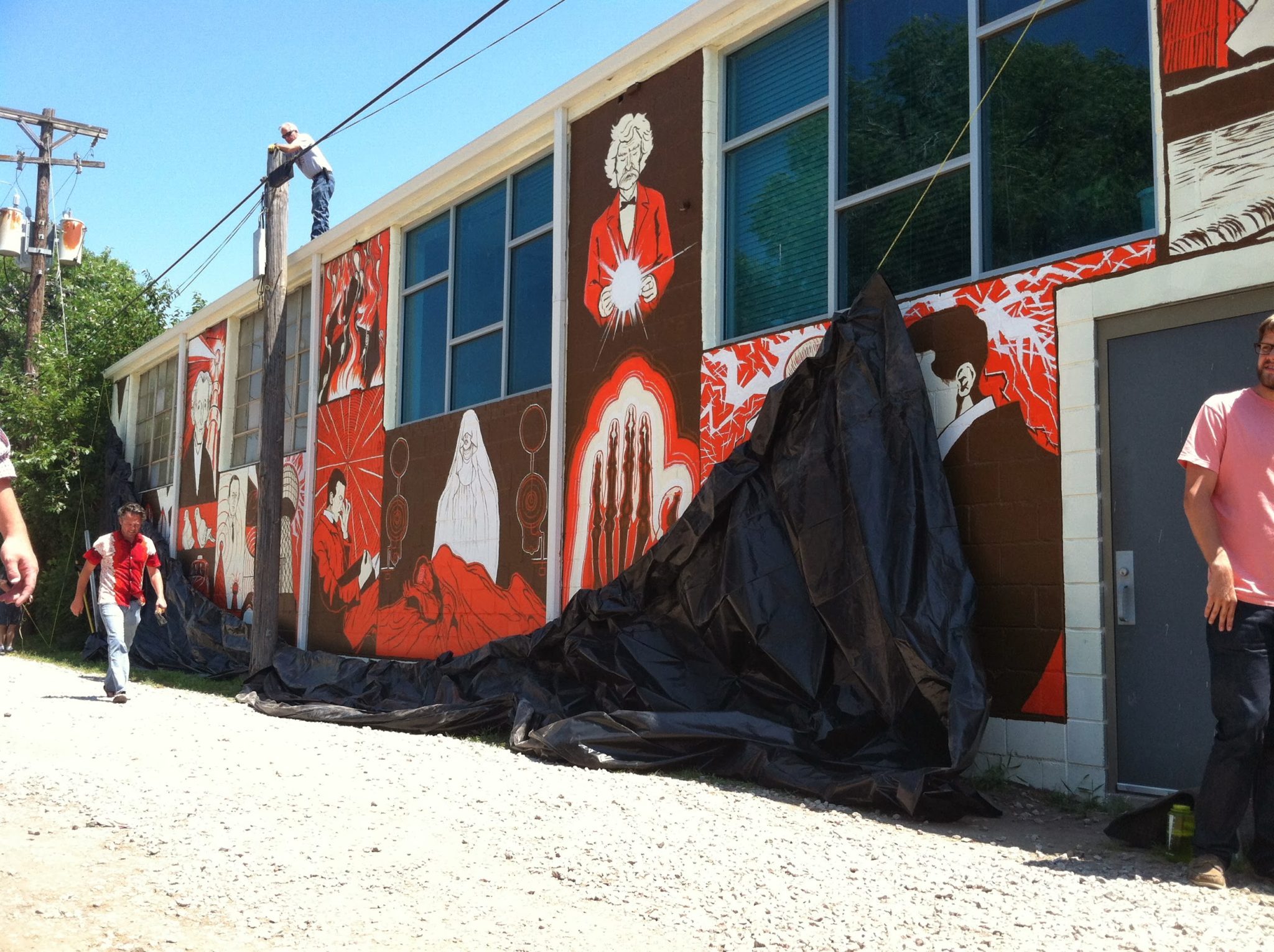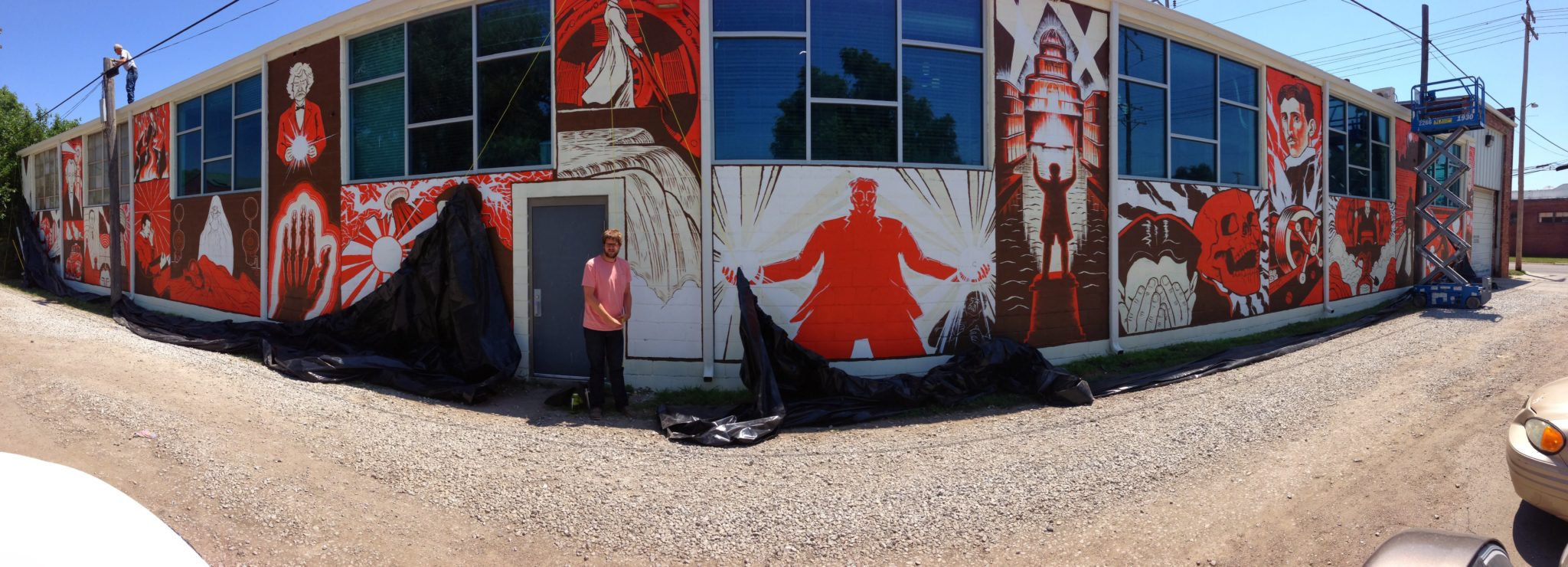All About
The Tesla Mural
The Tesla mural is an exterior mural on the west wall of the Turbine Flats building in Lincoln, Nebraska. Completed in July of 2013 and covering approximately 2,100 square feet, it illustrates events from the life of 20th-century inventor and electrical engineer Nikola Tesla. Rendered in sixteen narrative panels, the mural was designed by artist Amos Orion Sterns to be viewed from right to left.
Who Was Nikola Tesla
Why Turbine Flats
Turbine Flats is a collaborative environment for small and start-up businesses. Located at 2124 Y St in Lincoln, Nebraska, it is housed in a two-story brick and concrete block warehouse that was originally built in 1907 for the McGrew Machine Company. The building has a decorative brick facade on the south and east sides which face Y and North 22nd Street. Its north and west sides are concrete block additions built around 1917. Over the years the building was used to manufacture chicken incubators, assemble steel lockers for the military during WWII, machine tools for the Cushman Motor company, and as a garage for a limousine service.
In 2007 the building was bought by Matthew Wegener and Donna Gould. Matthew’s interest in Tesla started with his father’s stories about “that crazy inventor and his Tesla coils.” The more he learned about Tesla the more his admiration for the inventor grew. Eventually, the inventor became his greatest hero. Like Tesla, Matthew studied electrical engineering in college. Although he went on to become a computer programmer and business owner, he never lost his interest in Tesla’s life and work.
In 2008, when ISoft moved into Turbine Flats, Matthew began thinking about putting a mural on the building’s west side. The exposed concrete wall needed something, he felt. Something that celebrated inventors and innovators. Artist Amos Orion Sterns started working for ISoft Data Systems as a graphic designer in 2002. His interest in Nikola Tesla began in the 1990’s after watching a PBS-produced documentary about the inventor. That introduction encouraged him to read several books about Tesla. He developed a deep appreciation for Tesla’s pursuit of knowledge despite the challenges of health and finances that were present throughout the inventor’s life.
In 2009, Matthew talked with Amos about creating a Tesla mural for the west side of Turbine Flats. He envisioned something dramatic, like an epic lightning battle between Tesla and rival inventor Thomas Edison. Amos agreed with the subject matter but was more interested in exploring Tesla’s life story. He was also concerned about the potential for failure. The size of the space was bigger than anything he’d ever worked on before and he had concerns about creating on such a large scale. But after considering the space carefully, Amos decided he could make it work. He reacquainted himself with the details of Tesla’s life, revisiting the PBS documentary and the books on Tesla that he had read in the 90’s. In the summer of 2010, he sketched a draft of his ideas for the mural and presented it to Matthew. Matthew’s response after seeing the draft was, “I couldn’t wait to get it up on the wall. It was awesome.” But the management of Turbine Flats and ISoft Data needed Matthew’s full attention and the mural project was put on hold.

Two Years Later

Renewed Popularity
Concept and Design Process
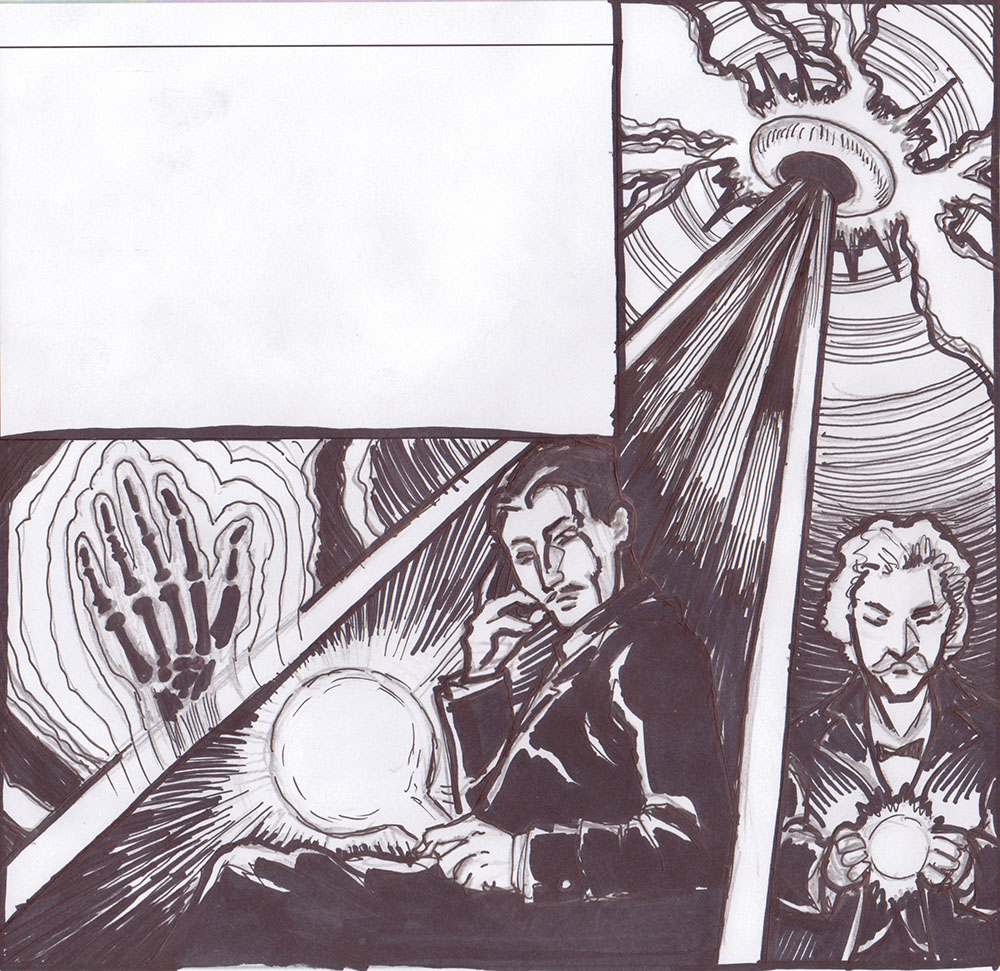
Telling Tesla
Second Draft
In June of 2010, Amos hand-drew a first draft of the mural and presented it to Matthew. Matthew loved the first draft, but the project was put on the back burner for the next three years. In early 2013, after Leo Glass was hired to manage the painting of the mural, Amos revisited the project and created a second draft, refining some of the imagery, adding photographic references and reversing the direction of the narrative timeline.
A unique characteristic of the Tesla mural is that it is meant to be viewed from right-to-left. Typically a mural illustrating a timeline would be “read” from left-to-right. In fact, the direction in the first draft of the mural was left-to-right. But in 2013, when Amos reassessed the design and the location, he recognized that the Turbine Flats building and its west wall were approached and viewed most often from the south, or “right”. Because of this, he decided to reverse the narrative timeline in his second draft, beginning the story of Tesla’s life on the right side of the space instead of the left.
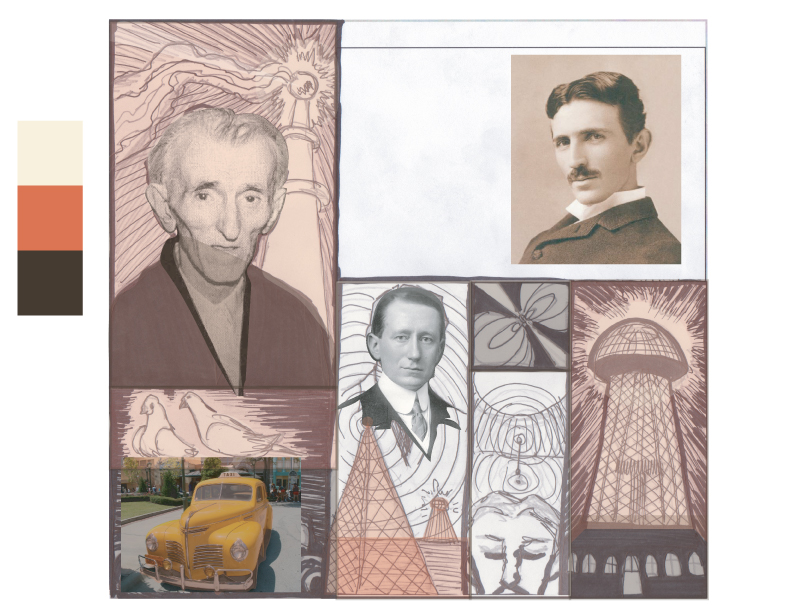
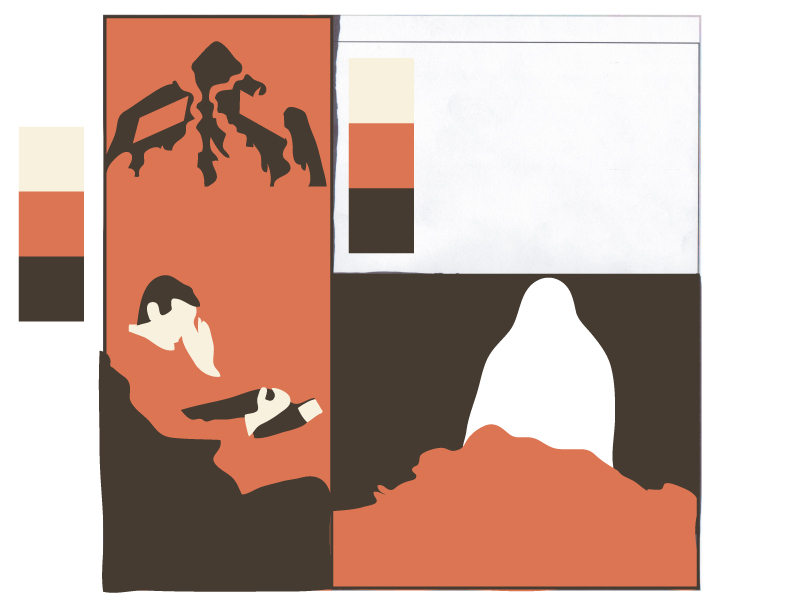
Third Draft
After Amos created the second draft of the mural, he and Matthew had a difference of opinion about the mural’s color palette. Matthew envisioned it as monochromatic, in brown and sepia tones. But Amos pushed for vibrancy. He wanted the graphic line style to be complemented by the palette. He saw the mural in four contrasting colors: a dark brown, a red-orange, a pale yellow and a warm white. He also felt that using a limited palette would make the painting process more efficient.
Ultimately Matthew agreed to the vibrant palette and Amos created a third draft of the mural to map out the blocks of color that needed to be underpainted before he could begin the line work. He then started the fourth draft to define the line work. But this draft was not finished, as he decided it would be better to improvise those details during the painting process.
Painting and Production

In February of 2013, Matthew told Amos and Leo he wanted the mural to be completed by Tesla’s birthday, July 10th. His plan was to unveil the mural to the Lincoln community and make it an event celebrating innovators, inventors, and engineers.
As the newly hired Executive Director of Turbine Flats, Leo Glass felt a little overwhelmed by the tight timeline of the project. Four months did not seem long enough to complete a mural of this size. After consulting with ISoft’s Office Manager, Emily Lowell, he decided to his goal would be to “just get some paint on the wall.”
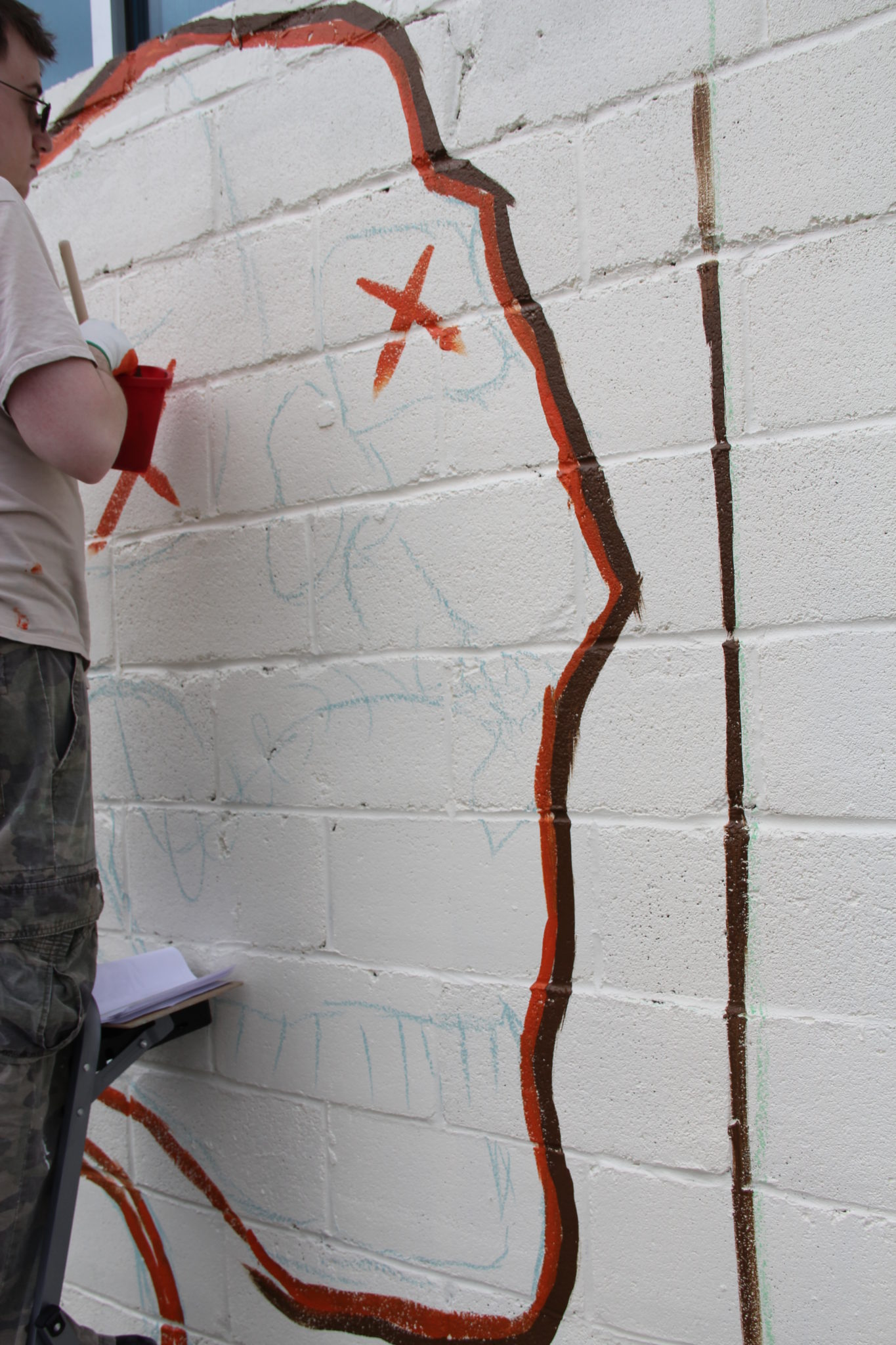 His first step towards that goal was to figure out exactly what kind of paint they should use on the wall. It needed to be long-lasting and resistant to the extremes of Nebraska’s winters and summers. After researching types of paints and paint manufacturers, Leo chose a high quality, water-based acrylic paint made by Behr to both prime the wall and paint the mural.
His first step towards that goal was to figure out exactly what kind of paint they should use on the wall. It needed to be long-lasting and resistant to the extremes of Nebraska’s winters and summers. After researching types of paints and paint manufacturers, Leo chose a high quality, water-based acrylic paint made by Behr to both prime the wall and paint the mural.
The first obstacle to “just get some paint on the wall” was that the roof, gutters, and downspouts on the west wall had to be updated. The roof was leaking and the existing steel gutters and downspouts had rusted extensively, staining the concrete wall. Additionally, the downspouts ran horizontally across several parts of the wall, visually cutting into the planned panels of the mural design.
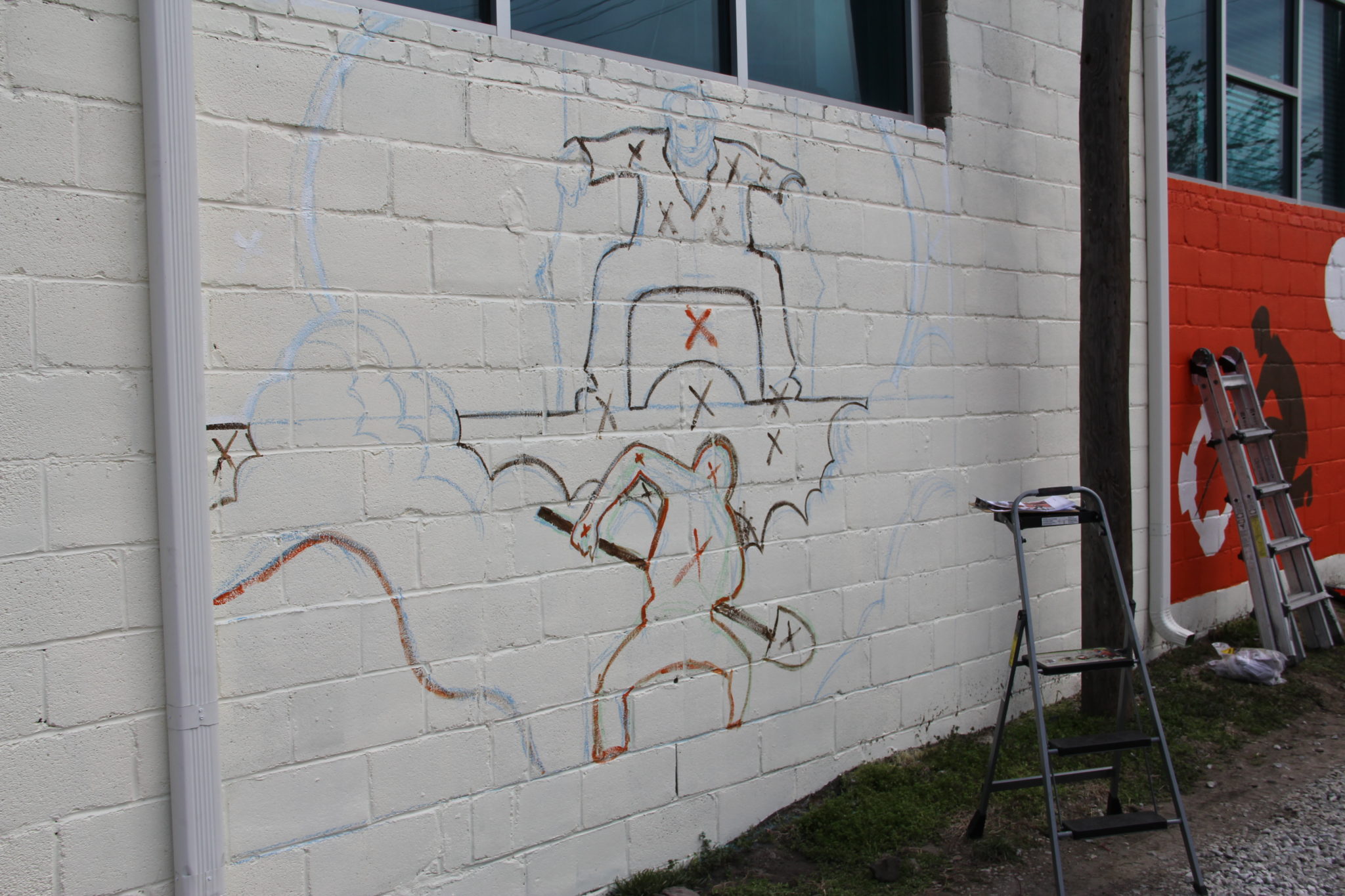 Leo and Amos urged Matthew to change the downspout positions during the replacement to open up the panels. Once he agreed, Leo arranged for the old gutters and downspouts to be removed. Then he put a power washer in the bed of a friend’s pickup truck and had them drive slowly along the wall as he sprayed the concrete clean from top to bottom.While a construction team worked to put up the new gutters along the roofline and vertical downspouts along the edges of the panels, Leo and a few volunteers filled in cracks and holes with mortar, then painted the wall with two coats of primer.
Leo and Amos urged Matthew to change the downspout positions during the replacement to open up the panels. Once he agreed, Leo arranged for the old gutters and downspouts to be removed. Then he put a power washer in the bed of a friend’s pickup truck and had them drive slowly along the wall as he sprayed the concrete clean from top to bottom.While a construction team worked to put up the new gutters along the roofline and vertical downspouts along the edges of the panels, Leo and a few volunteers filled in cracks and holes with mortar, then painted the wall with two coats of primer.
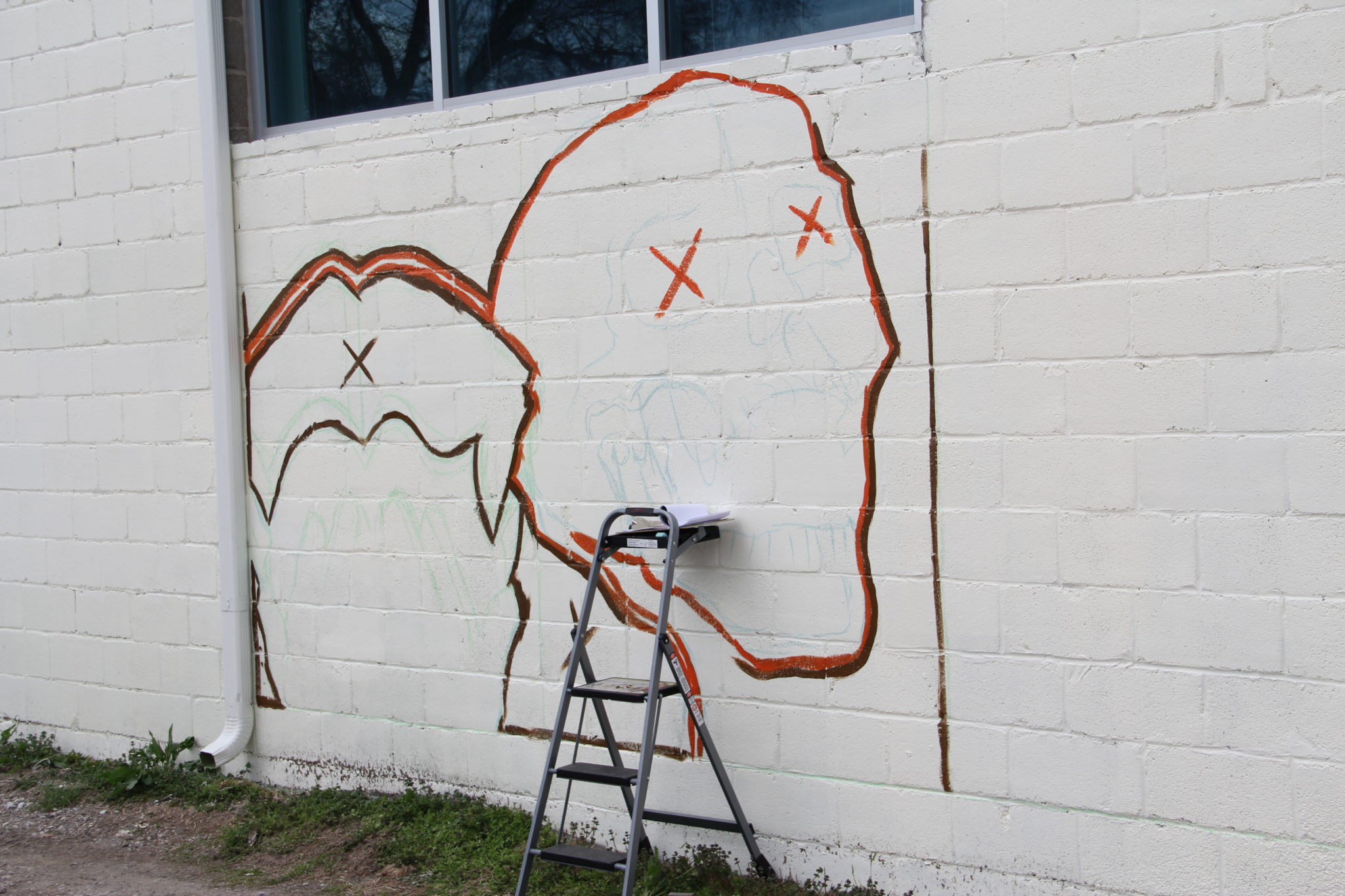 Although the roof work still needed to be done, Leo, Amos, and Matthew felt it was time to start working on the color blocks and panels for the underpainting. Matthew suggested projecting the third draft on the wall and tracing the shapes in the correct scale. Amos thought that he could freehand the color blocks to scale on the panels without the complications of a projector. As a test, he used colored sidewalk chalk to draw outlines for the color blocks on the first panel and was able to scale up them up to the correct panel dimensions by eye.
Although the roof work still needed to be done, Leo, Amos, and Matthew felt it was time to start working on the color blocks and panels for the underpainting. Matthew suggested projecting the third draft on the wall and tracing the shapes in the correct scale. Amos thought that he could freehand the color blocks to scale on the panels without the complications of a projector. As a test, he used colored sidewalk chalk to draw outlines for the color blocks on the first panel and was able to scale up them up to the correct panel dimensions by eye.
Volunteers Assemble
Leo had gathered a group of volunteers to paint the color blocks. He suggested Amos paint a swatch of the correct color inside each shape and outline it so the volunteers would know exactly where and what to paint. Amos and the volunteers began working concurrently. He moved north along the wall, panel by panel, chalking out the color block shapes, then painting swatches and shape outlines. The volunteers followed, painting in the shapes with the correct color, like a paint by number project.
The mural volunteers were employees of iSoft and other businesses in the Turbine Flats offices who responded to Leo’s call for help. They painted the mural color blocks over their lunch breaks, after work or on the weekends. Leo was with them every day, setting up the paint and brushes, providing the volunteers with pizza, maintaining ladder safety, and making sure Amos could work without being bothered.

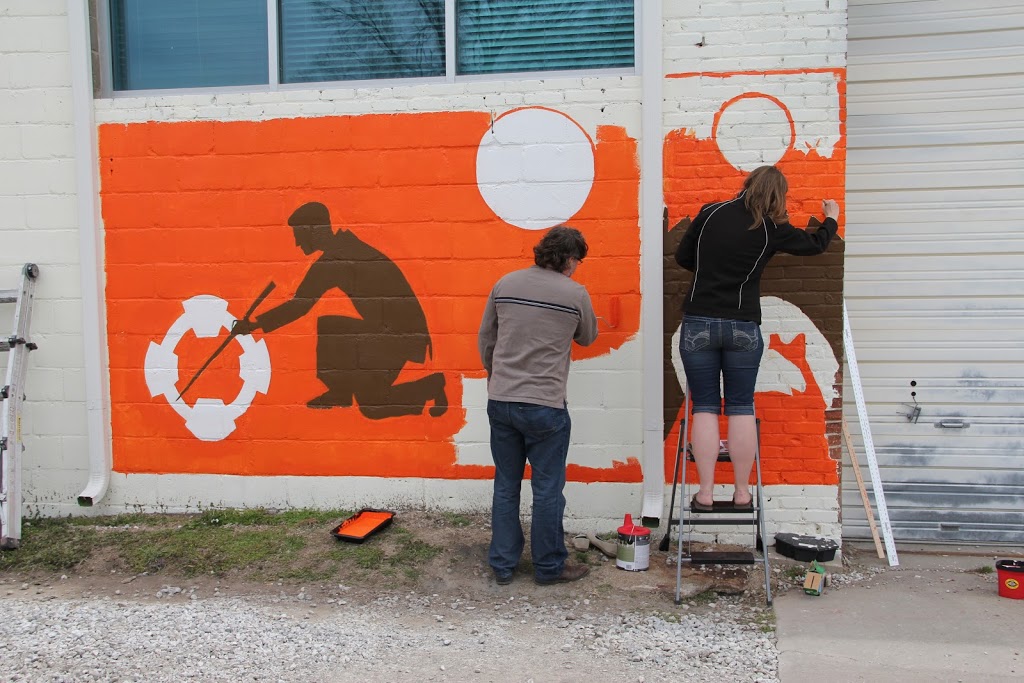
Obstacles Abound
Even with Leo’s careful management, the crew faced obstacles to getting paint on the wall. The Turbine Flats parking lot on the west side of the building was unpaved, so every week Leo had to wash mud and dust off the wall to keep the surface clean enough for the paint to adhere to the concrete. Later in the project, a bucket left on the roof by the repair crew tipped over during a thunderstorm and dripped tar onto the top of one of the colorblocked panels. The panel had to be cleaned and repainted before Amos could continue working.
As the volunteers worked on the color blocking, Amos went back to the south end of the wall and began adding line work and detail. To get the types of lines he wanted, he used two kinds of brushes: house painting brushes that tapered to a chiseled end, and art brushes with a flat, oval shape. The chiseled brushes created a solid, thick line. The art brushes handled the paint differently and created a broken, delicate line that Amos used for fine details on faces and hands.
Work Continues
Caring for the brushes was important because they needed to last for the whole project. Every day, Amos would set up a bucket and a brush for each color he was using and a separate cleaning bucket with warm, soapy water. During the day’s painting, he was careful to keep the brushes from getting caked with paint. Once a brush was done for the day, he would wash it and then leave it to soak in the cleaning bucket. The brushes and the bucket were magnetized so the brushes hung from the sides, keeping their tips from bending or breaking against the bottom of the bucket.
As the days got longer, the afternoons got too hot for Amos to paint. He started coming in to work on the Tesla mural in the mornings, from about 6 am to noon and spending the afternoons assisting Leora Platte, another local artist, with painting an indoor mural in downtown Lincoln.
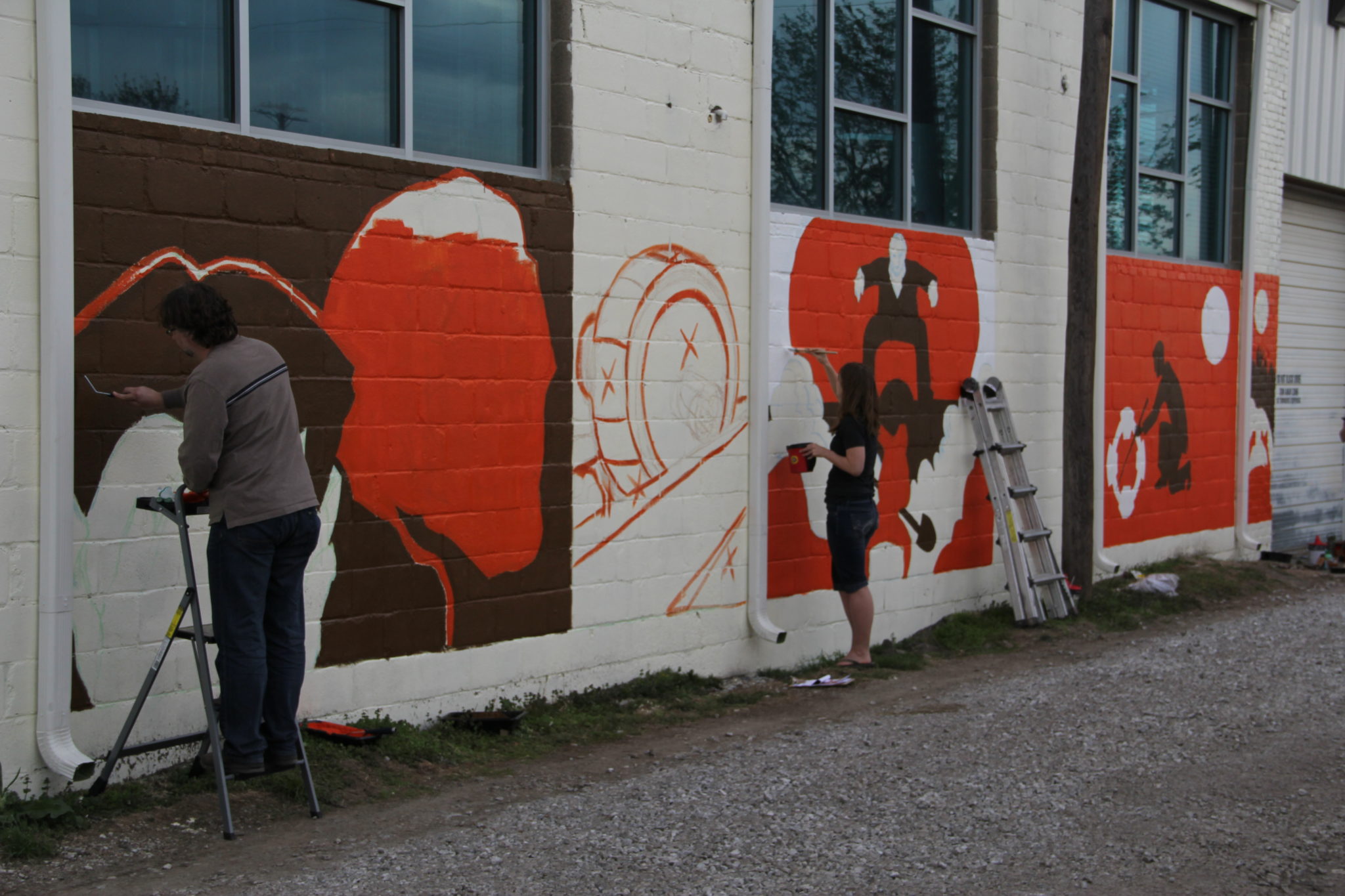
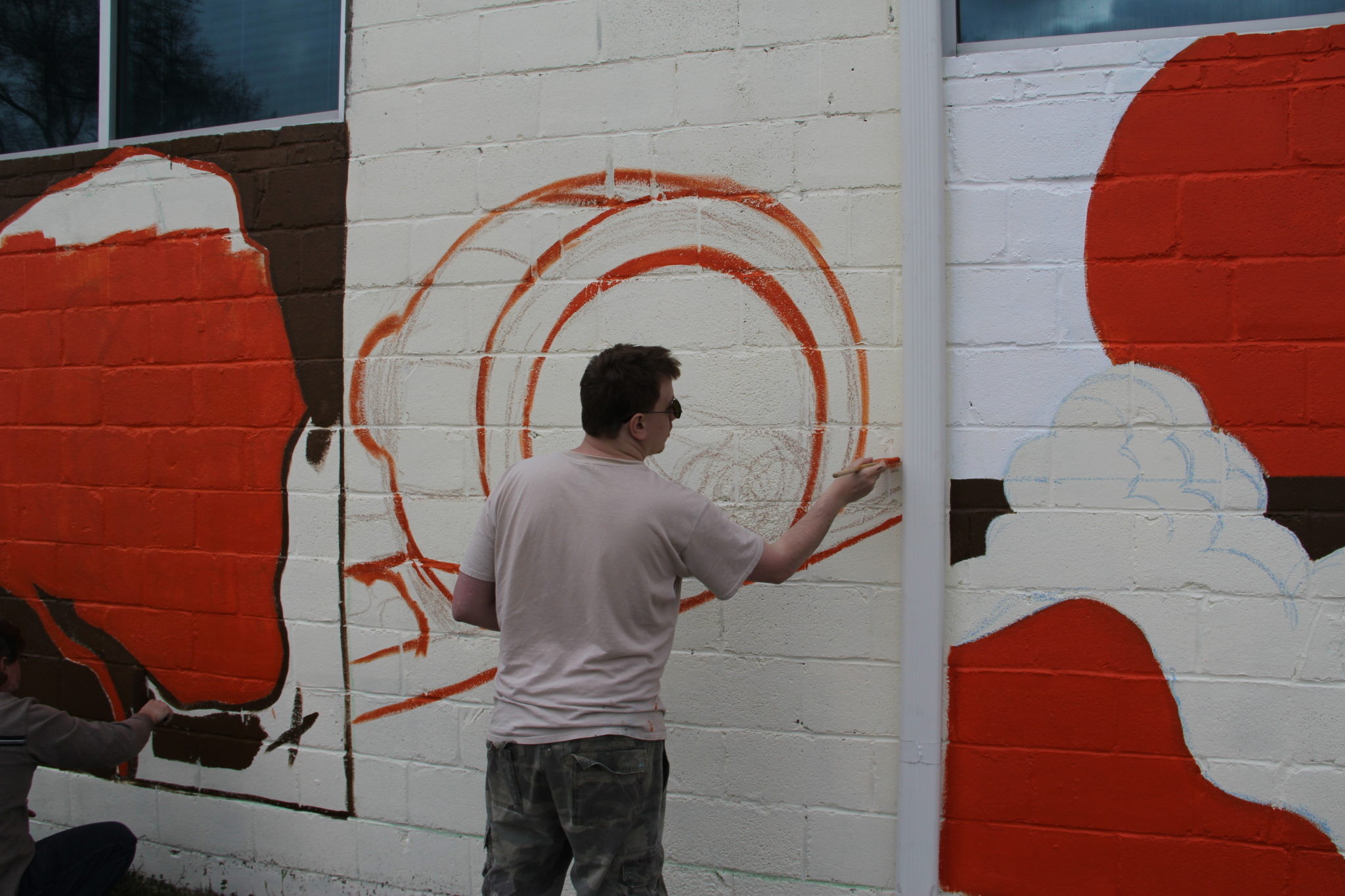
Close To Completion
Despite all the volunteer help, some of the underpainting on the vertical panels wasn’t finished enough for Amos to work on. Leo and iSoft employee Diana Ramos used a scissor lift over several hot afternoons to reach the tops of the vertical panels, tidying up panel edges and color block outlines so Amos could continue to paint in the morning.
As the mural got closer to completion, Amos considered finishing it with a sealant to protect the work. But after doing some research, he learned that any kind of sealant would cause the original paint colors to change over time, making paint matching very difficult for repairs or touch-ups. As he anticipated the mural would need repair in the future, he decided against using a sealant coat.
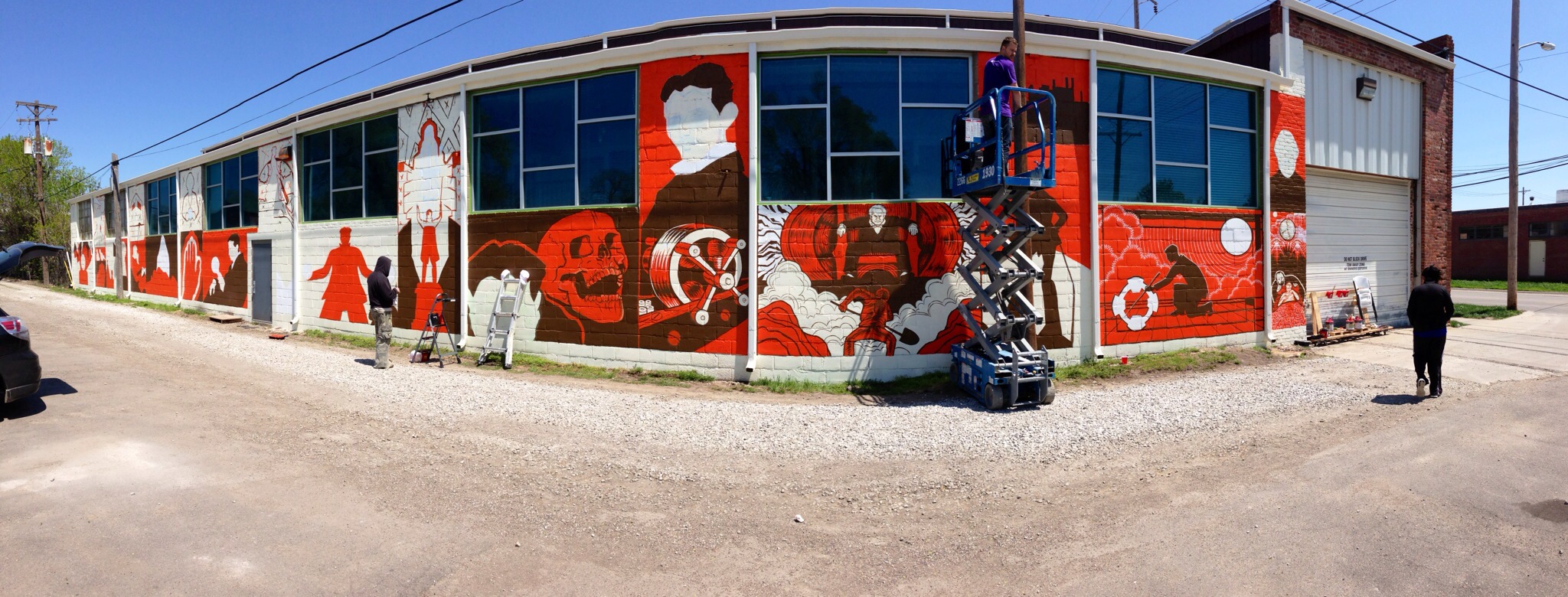
The Day of the Innovator
To allow the most people to attend, the mural unveiling was set for July 12th, the weekend closest to Tesla’s birthday (July 10th). Matthew decided to call the event “The Day of the Innovator” in Tesla’s honor. On the evening of Friday, July 11th, Leo, Matthew and several mural volunteers worked to cover the completed mural with two long sheets of black plastic. Both sheets were rigged to a central rope that, when cut, would drop them to the ground, revealing the mural.
Saturday, July 12th, 2013 was a typical hot and humid Nebraska summer day. By the afternoon, the temperature had reached a high of 105 degrees in the city of Lincoln. At Turbine Flats, over one hundred people gathered in the west parking lot to see the mural unveiling. While they waited, they sheltered from the sun under tents, cooled down with handcrafted popsicles from Pop Art, looked at locally owned Tesla cars on display, listened to live music from local musicians, and were awed by the lightning display from Matthew’s homemade Tesla coil. The kids in the crowd hung out at a table set up by Turbine Flats intern Ashley Sahs, who had created a game that used watch batteries to race toy cars.
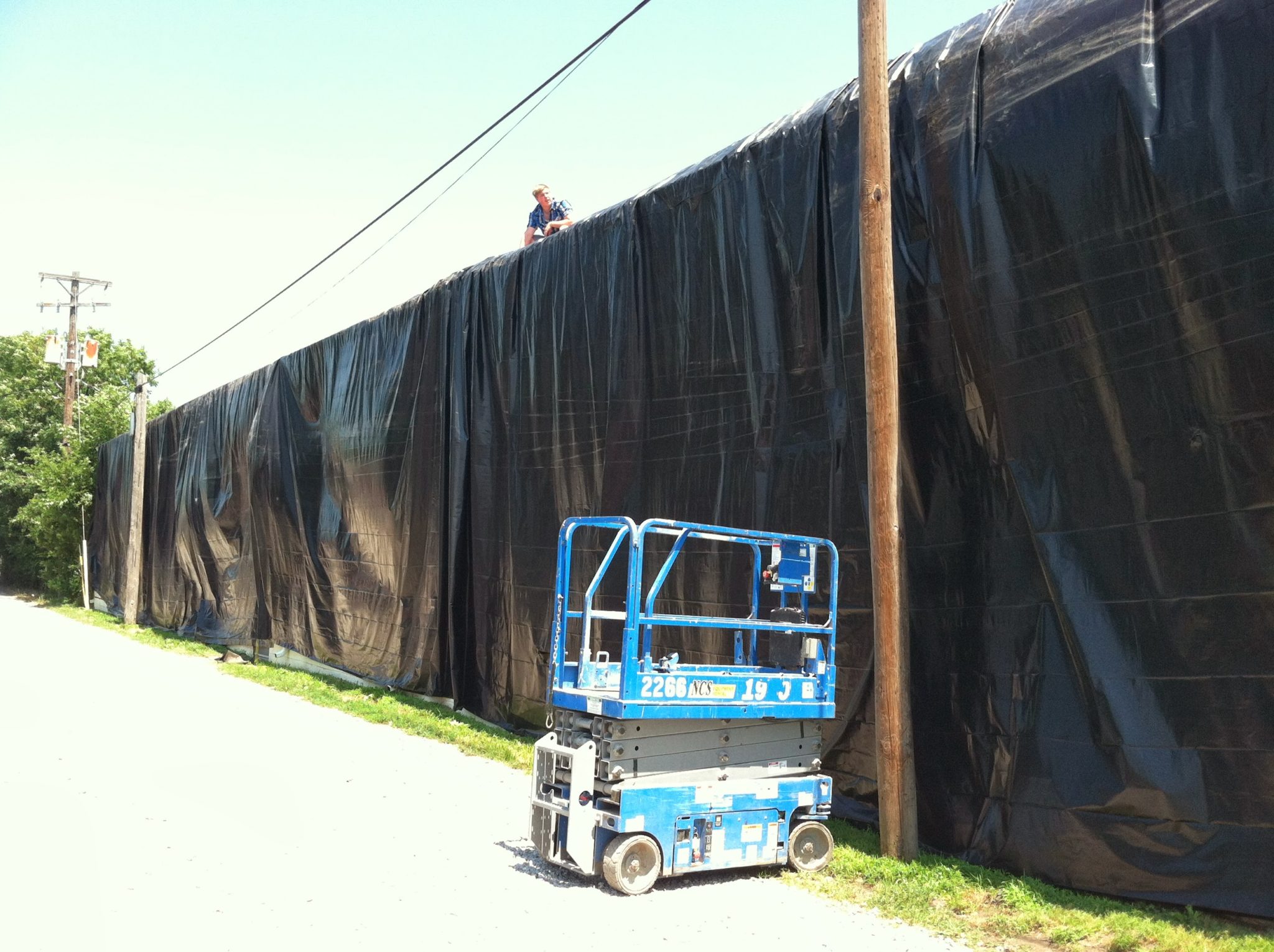
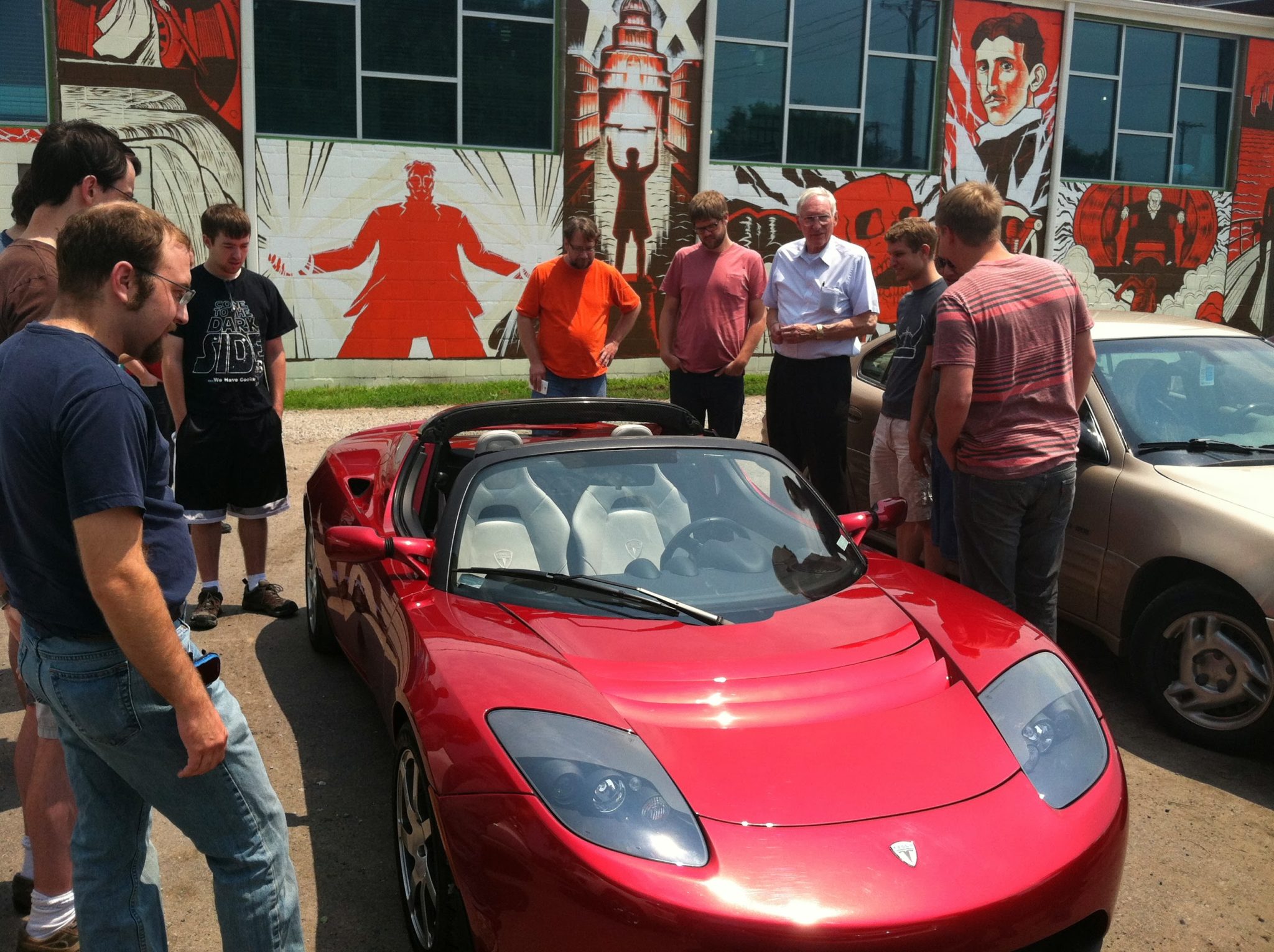
Tesla Mural Unveiled
Leo Glass opened the unveiling ceremony by reflecting that he came from a family who couldn’t refuse an impossible task. He told stories about several family members who overcame great challenges, even when the odds seemed insurmountable. He expressed gratitude for the support their experiences gave him as he worked with the challenging timeline of the mural project. Then he thanked the mural volunteers for their hard work and expressed his admiration for the innovators and inventors who took on their own impossible tasks throughout human history.
Kurt Hesser from Lincoln Chamber of Commerce noted that he’d worn a suit, despite the July heat, and would keep his comments short. He went on to recognize the Turbine Flats Project for providing Lincoln’s entrepreneurs with a collaborative environment in which to grow.
Mayor Chris Beutler spoke regarding the determination required for innovation and the resistance any new idea faces. Quoting Tesla he said, “All that was great in the past was ridiculed, condemned, combated, suppressed - only to emerge all the more powerfully, all more the more triumphantly from the struggle.” The Mayor praised the Turbine Flats Project for being the first business to open in Lincoln’s Antelope Valley Redevelopment area, then formally proclaimed Saturday, July 12th as Lincoln’s “Day of the Innovator” and presented a commemorative plaque to Matthew for the work of Turbine Flats in the community.
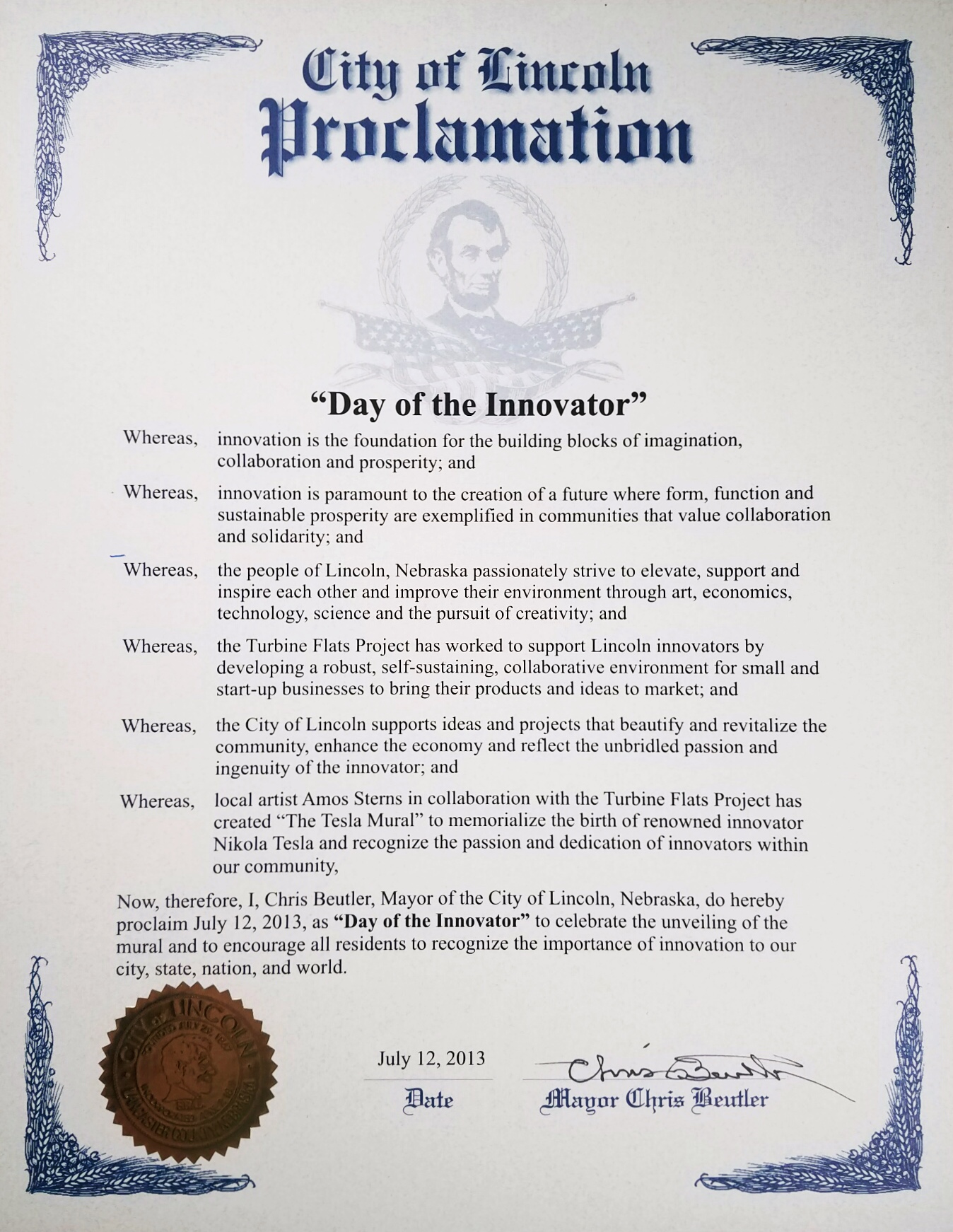
Honored
Matthew Wegener began his comments with a quote from President John F. Kennedy: “We choose to go to the moon...and do the other things. Not because they are easy but because they are hard...” Matthew pointed out the importance of adversity to human civilization and how innovators are often responsible for moving civilization forward because they are willing to take on impossible challenges. He then thanked the Chamber of Commerce and the mayor's office for supporting the “Day of the Innovator.” He thanked Leo Glass for his work in making the mural project a reality. He also thanked Emily Lowell, Ashley Sahs, the Tesla car owners who had brought their vehicles to the event and Hear Nebraska for providing music at the event. Finally, he expressed his gratitude to Amos Sterns for his creativity and the gravity of his work. Matthew encouraged people to view Amos’s original (now framed) draft of the mural and shared a final quote from President Kennedy: “We believe that we must do better, we must improve….we must do those things which are giant, not just for ourselves but for our community and for our humanity.”
A pair of oversized ceremonial scissors was provided by the mayor’s office to cut the cord for the mural reveal. While Matthew pulled the plastic sheets away from the cord, Amos attempted to cut it with the scissors. But the scissor blades were not sturdy enough to cut the cord and instead caused one of the sheets of plastic to droop along the wall, revealing a glimpse of the mural. Matthew took the scissors and made a second attempt to cut the cord with no success. A quick-thinking audience member handed Amos a pocket knife which he used to sever the cord. Both plastic sheets fell to the ground, revealing the Tesla mural to the crowd, who applauded loudly.
Amos wrapped up the unveiling with a brief speech in which he thanked Matthew for pushing him to take on the project, admitting he was “bewildered by the support that people have shown for my naive comic strip” and closed by saying, "I would be extremely happy if this mural and this event were to spread the appreciation of Tesla’s generosity toward humanity."
I would be extremely happy if this mural and this event were to spread the appreciation of Tesla’s generosity toward humanity.
Beyond Lincoln - After the Unveiling
On Tesla’s birthday, July 10th, a friend of Matthew’s took photos of the mural and posted them to the photo-sharing site Imgur under the username “csteinheider.” A few hours later on Reddit, a popular content aggregator site, user “sadlegoface” shared the Imgur post to the sub-reddits: r/pics and r/Nebraska. That same day, comic creator and Tesla fan Matthew Inman shared the Imgur post on The Oatmeal’s Facebook page, writing “Lincoln, Nebraska will reveal the world’s largest mural of Tesla’s life on Friday. This looks f*ing awesome.”
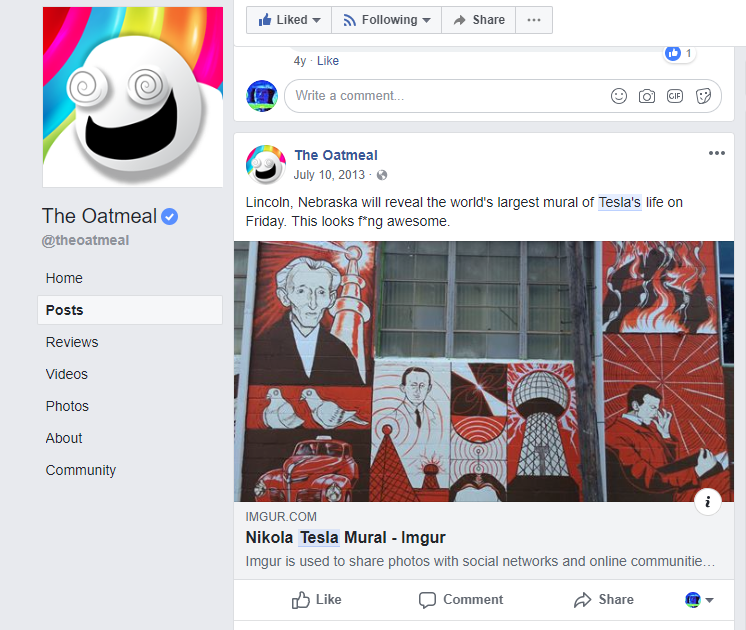 After the unveiling, Lincoln residents and visitors often stopped by Turbine Flats to find out more about the mural and take photos of it. In 2017 the mural was tagged with graffiti on one of the center panels, which depicts Tesla holding two lightbulbs labeled “a” and “c”. The damage was easily repaired, thanks to the quality of paint and lack of sealant.
After the unveiling, Lincoln residents and visitors often stopped by Turbine Flats to find out more about the mural and take photos of it. In 2017 the mural was tagged with graffiti on one of the center panels, which depicts Tesla holding two lightbulbs labeled “a” and “c”. The damage was easily repaired, thanks to the quality of paint and lack of sealant.
By 2018 the mural began showing some damage from weather and moisture seepage from the old concrete and masonry. In May of 2018, paint was removed from the damaged sections. The crumbling masonry was patched and then treated with an acrylic sealant. Amos repainted the damaged sections to match his original work. As of this writing, the Turbine Flats Tesla Mural remains the largest mural in the world celebrating Tesla’s life story.
Amos Orion Sterns
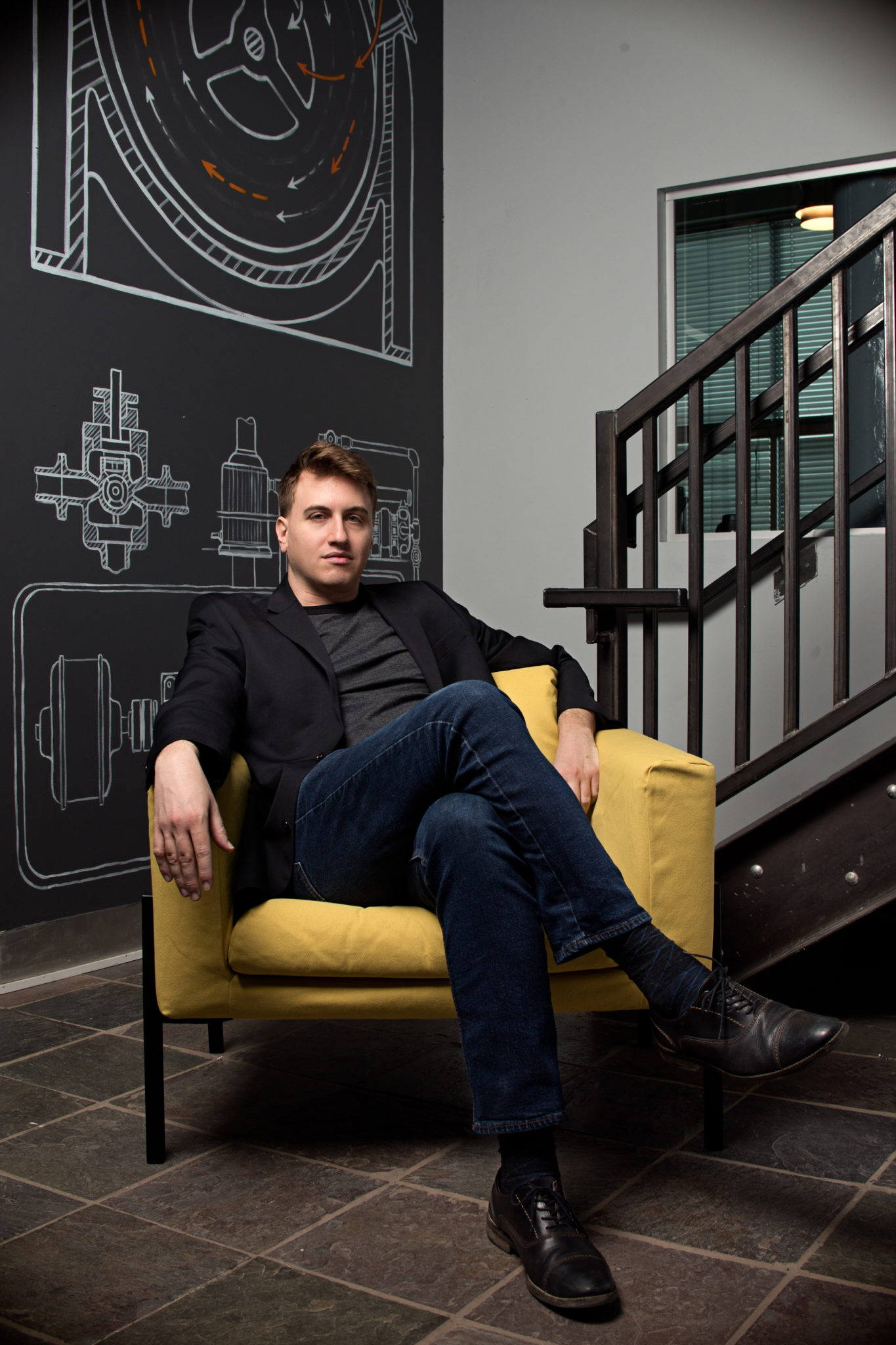 The work of Amos Orion Sterns is a detailed exploration of faces and figures set in soft focus, abstract backgrounds. Working in acrylics and ink, Amos captures his subject with simple lines, then pulls the lines beyond their boundaries, refracting the form into complex shapes and abstractions. His heavy, illustrative line and cross contour treatment of interior space creates a web of focus around his subjects, drawing the viewer’s eye to the powerful negative space at the heart of each work.
The work of Amos Orion Sterns is a detailed exploration of faces and figures set in soft focus, abstract backgrounds. Working in acrylics and ink, Amos captures his subject with simple lines, then pulls the lines beyond their boundaries, refracting the form into complex shapes and abstractions. His heavy, illustrative line and cross contour treatment of interior space creates a web of focus around his subjects, drawing the viewer’s eye to the powerful negative space at the heart of each work.
Amos’s mother, also an artist, encouraged his artistic development and especially impressed on him an appreciation for her favorite artists from Europe’s Old Renaissance Masters, as well as Impressionists, and later Romantic painters and illustrators. These influences competed with the formative pop-imagery of his youth: powerful characters from cartoons, comics, and early video games. Together these disparate styles became powerful influences on his perception of art.
Experimenting during the early days of computer graphics and dabbling in animation helped Amos get into the fine arts and design program at Nebraska Wesleyan University in 2001. It was there that he first began painting, mostly studies in oils. Always prone to looking backward in time for inspiration, he excelled in art history and fell in love with the work of American painter and portraitist John Singer Sargent. These studies led him to incorporate more paint and brush textures into his naturally graphic style. In 2005, Amos earned his BFA in studio art from Wesleyan.
In 2008 Amos started a painting series that ultimately resulted in twenty portraits. This unnamed series began with an old photo Amos had taken of his sister Anna while she was sleeping. Rediscovering the photo in his files at work, Amos was moved by it to create something immediately. He found a recycled piece of matte board to be the canvas. A bottle of ink and a pot of old coffee served as paint. With these scavenged tools he captured his sister’s profile, framed in a nest of twining, graceful lines and washed with sepia tones. The finished work was well-received and he went on to capture the portraits of family members, friends, and co-workers for the series. Although he chose not to use alternative paint or canvas materials again in these paintings, he did replicate the coffee and ink color wash with water-thinned acrylic paint.
In 2010 Amos was doing visual research for the Tesla mural project. For an artist fascinated by faces, Tesla was a wonderful challenge. Although Amos never saw the mural as a portrait-centered project, he was intrigued to see how Tesla’s face changed from photograph to photograph and over time as portraits were taken throughout his life. As Amos drafted the mural design, he copied the figure positions from each photograph faithfully, but in the actual painting of the mural, he interpreted the details of Tesla’s face and figure in a graphic arts style, using textured brushstrokes to provide both line and tone.
Amos had to approach the Tesla mural differently from his previous works. His biggest concerns about the project were: the tight timeline for creating the work, the scale of the materials required to paint a project of this size and the texture of the concrete canvas. Amos has stated that although ultimately he feels the project was successful, in retrospect there is “a roughness to the overall work that I sometimes like and sometimes don’t.”
Since completing the Tesla mural, Amos has continued to do commissioned portraits and illustrations for roleplaying game rulebooks and adventure modules. “My life and my work are part of an ongoing puzzle,” he says.


